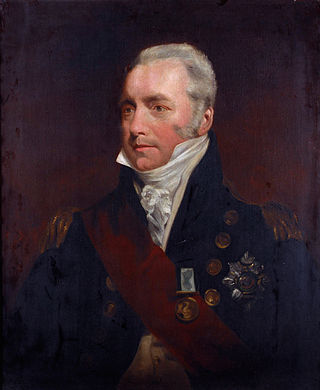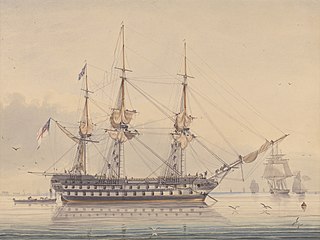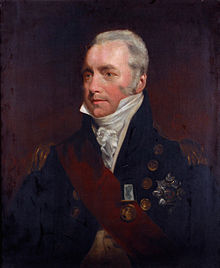
HMS Bellerophon, known to sailors as the "Billy Ruffian", was a ship of the line of the Royal Navy. A third-rate of 74 guns, she was launched in 1786. Bellerophon served during the French Revolutionary and Napoleonic Wars, mostly on blockades or convoy escort duties. She fought in three fleet actions: the Glorious First of June (1794), the Battle of the Nile (1798) and the Battle of Trafalgar (1805). While the ship was on blockade duty in 1815, Napoleon boarded Bellerophon so he could surrender to the ship's captain, ending 22 years of almost continuous war between Britain and France.

Admiral of the Red James Saumarez, 1st Baron de Saumarez, GCB was an admiral of the British Royal Navy, known for his victory at the Second Battle of Algeciras.

HMS Superb was a 74-gun third-rate ship of the line of the Royal Navy, and the fourth vessel to bear the name. She was launched on 19 March 1798 from Northfleet, and was eventually broken up in 1826. Superb is mostly associated with Richard Goodwin Keats who commanded her as captain from 1801 until his promotion in 1806. Keats famously spent only one night out of the ship during four and a half years out of a home port. She also served as his flagship from early 1808 until she was paid off in 1809.

The Battle of San Domingo was a naval battle of the Napoleonic Wars fought on 6 February 1806 between squadrons of French and British ships of the line off the southern coast of the French-occupied Spanish colonial Captaincy General of Santo Domingo in the Caribbean.

HMS Polyphemus, a 64-gun third-rate ship of the line of the Royal Navy, launched on 27 April 1782 at Sheerness. She participated in the 1801 Battle of Copenhagen, the Battle of Trafalgar, and the Siege of Santo Domingo. In 1813 she became a powder hulk and was broken up in 1827.

Admiral Sir Richard Goodwin Keats GCB was a British naval officer who fought throughout the American Revolution, French Revolutionary War and Napoleonic War. He retired in 1812 due to ill health and was made Commodore-Governor of Newfoundland from 1813 to 1816. In 1821 he was made Governor of Greenwich Hospital in Greenwich, London. Keats held the post until his death at Greenwich in 1834. Keats is remembered as a capable and well respected officer. His actions at the Battle of Algeciras Bay became legendary.

HMS Implacable was a 74-gun third-rate ship of the line of the Royal Navy. She was originally the French Navy's Téméraire-class ship of the line Duguay-Trouin, launched in 1800.

HMS Hannibal was a 74-gun third-rate ship of the line of the Royal Navy, launched on 15 April 1786, named after the Carthaginian general Hannibal. She is best known for having taken part in the Algeciras Campaign, and for having run aground during the First Battle of Algeciras on 5 July 1801, which resulted in her capture. She then served in the French Navy until she was broken up in 1824.
Vice-Admiral Sir James Nicoll Morris KCB was a Royal Navy officer who served through the American Revolutionary War, French Revolutionary Wars, and Napoleonic Wars. He joined the Royal Navy in 1772 and subsequently fought as a junior officer in the Leeward Islands in the battles of St Lucia, Grenada, and the Saintes. He was promoted to commander in 1790, going to the Leeward Islands where he commanded HMS Flirt, and then he similarly had HMS Pluto on the Newfoundland Station. Morris was promoted to post-captain in 1793 and given command of HMS Boston, in which he became a successful prizetaker around Cape Finisterre. In 1798 he transferred to command HMS Lively but in April that ship was wrecked off Cadiz. His next command was HMS Phaeton in the following year. In Phaeton Morris fought in the Mediterranean, assisting the Austrian battles against French forces in Italy.
HMS Spencer was a 74-gun third-rate ship of the line of the Royal Navy, launched on 10 May 1800 at Bucklers Hard. Her designer was the French émigré shipwright Jean-Louis Barrallier. She served in two major battles, Algeciras Bay and San Domingo, and in a number of other campaigns. She was broken up in 1822.

HMS Donegal was launched in 1794 as Barra, a Téméraire class 74-gun ship of the line of the French Navy. She was renamed Pégase in October 1795, and Hoche in December 1797. The British Royal Navy captured her at the Battle of Tory Island on 12 October 1798 and recommissioned her as HMS Donegal.
Lamellerie's expedition was a French naval operation launched in February 1806. Four French Navy frigates and a brig, all survivors of the Battle of Trafalgar in October 1805, attempted to break past the British blockade of Cadiz on 23 February 1806, taking advantage of the withdrawal of the principal blockade squadron several months earlier at the start of the Atlantic campaign of 1806. Although the squadron was intercepted by elements of the British blockade force, Captain Louis-Charles-Auguste Delamarre de Lamellerie escaped with the four frigates by abandoning the slower brig, which was captured. During the next six months, Lamellerie's squadron cruised the Atlantic, visiting Senegal, Cayenne and the West Indies but failing to cause any significant disruption to British trade.
Admiral Sir Lawrence William Halsted GCB was an officer of the Royal Navy who served during the American War of Independence and the French Revolutionary and Napoleonic Wars.

HMS Terpsichore was a 32-gun Amazon-class fifth-rate frigate of the Royal Navy. She was built during the last years of the American War of Independence, but did not see action until the French Revolutionary Wars. She served during the French Revolutionary and Napoleonic Wars, in a career that spanned forty-five years.

The Algeciras campaign was an attempt by a French naval squadron from Toulon under Contre-Admiral Charles Linois to join a French and Spanish fleet at Cadiz during June and July 1801 during the French Revolutionary Wars prior to a planned operation against either Egypt or Portugal. To reach Cadiz, the French squadron had to pass the British naval base at Gibraltar, which housed the squadron tasked with blockading Cadiz. The British squadron was commanded by Rear-Admiral Sir James Saumarez. After a successful voyage between Toulon and Gibraltar, in which a number of British vessels were captured, the squadron anchored at Algeciras, a fortified port city within sight of Gibraltar across Gibraltar Bay. On 6 July 1801, Saumarez attacked the anchored squadron, in the First Battle of Algeciras. Although severe damage was inflicted on all three French ships of the line, none could be successfully captured and the British were forced to withdraw without HMS Hannibal, which had grounded and was subsequently seized by the French.
Sir Henry Heathcote was an officer of the Royal Navy who served during the French Revolutionary and Napoleonic Wars.

The Second Battle of Algeciras was a naval battle fought on the night of 12 July 1801 between a squadron of British Royal Navy ships of the line and a larger squadron of ships from the Spanish Navy and French Navy in the Gut of Gibraltar.

Richery's expedition was a French naval operation during 1795 and 1796 as part of the French Revolutionary Wars. The operation was led by Commodore Joseph de Richery and comprised two separate cruises; the first was an operation off Cádiz in Southern Spain in which Richery attacked and defeated a large British merchant convoy with a weak escort, taking many prizes. Forced to anchor at Cádiz, the French squadron was subsequently blockaded in the port for almost a year. Richery was enabled to escape in August 1796 by a Spanish fleet, and went on to attack British fisheries off Newfoundland and Labrador before returning to France having inflicted severe damage to British Atlantic trade.

Vice-Admiral Sir Charles Richardson was a British naval officer of the 18th and 19th centuries. His naval career began when he joined HMS Vestal as a captain's servant in 1787. In Vestal he made an aborted journey to China before serving on the East Indies Station where he transferred to HMS Phoenix and fought in the Battle of Tellicherry and the Third Anglo-Mysore War in 1791 and 1792. Having returned to England as a master's mate, Richardson fought at the Glorious First of June on HMS Royal George in 1794 before being promoted to lieutenant in HMS Circe. In 1797, he successfully combated the Nore mutiny in Circe before fighting in the Battle of Camperdown where he personally captured the Dutch admiral Jan Willem de Winter. Afterwards he became flag lieutenant to Admiral Adam Duncan and fought at the Battle of Callantsoog and the Vlieter Incident in the Anglo-Russian invasion of Holland of 1799. He then sailed to Egypt in HMS Kent where he again went onshore, fighting in the battles of Abukir, Mandora, and Alexandria in 1801.

HMS Beaulieu was a 40-gun fifth-rate frigate of the Royal Navy. The ship was laid down in 1790 as a speculative build by the shipwright Henry Adams and purchased by the Royal Navy in June of the same year. Built to the dimensions of a merchant ship, Beaulieu was broader, with more storage capacity, than a standard frigate; though may not have had good sailing qualities. The frigate was commissioned in January 1793 by Lord Northesk and sent to serve on the Leeward Islands Station. She participated in the capture of Martinique in February 1794, and then was similarly present at the capture of the island of Saint Lucia in April. The frigate also took part in the initial stages of the invasion of Guadeloupe. Later in the year the ship's crew was beset by yellow fever and much depleted. Beaulieu was sent to serve on the North America Station to allow them to recuperate, returning to the Leeward Islands in 1795. In the following two years the ship found success in prizetaking and briefly took part in more operations at Saint Lucia. She returned to Britain at the end of 1796.






















